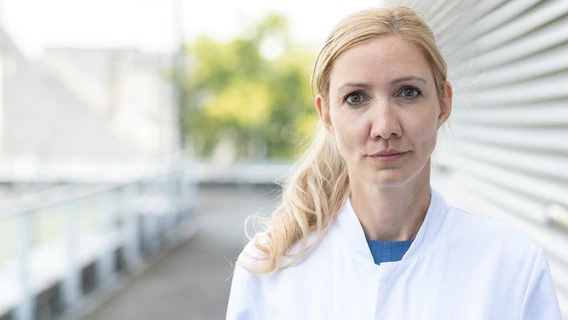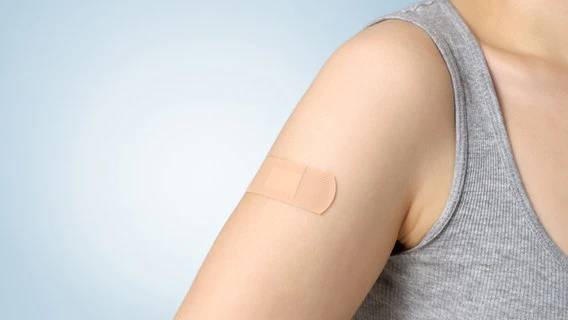Status: 03/01/2022 5:47 p.m
In the coronavirus update from NDR Info, virologist Christian Drosten explains why FFP2 masks should remain the method of choice and why the podcast episodes with him and Sandra Ciesek will end at the end of March.
Spring is approaching and the number of infections in Germany is falling – slowly and still at a high level, but the development of the pandemic gives hope for a relatively relaxed summer. Will it be like 2021 again? “Last year the incidence went down very quickly with the warm temperatures,” says Drosten. “But we will hardly make any progress with the current vaccination progress and have significant infection activity from Omicron. Therefore I assume that there will not be an infection-free summer.”
FFP2 mask most efficient in the long run
There are both mathematical justifications (modeling) and reality-based ones from other countries. In South Africa, for example, the omicron wave rose sharply in the middle of midsummer, despite the high temperatures. “I don’t think we’re going to see an untamed wave in summer. But you can also get infected with this omicron virus in summer.” The advice of the head of virology at the Berlin Charité: keep the mask requirement indoors. “In the long term, wearing an FFP2 mask indoors is certainly the most efficient measure , which should be maintained.”
Another winter wave will come
If the temperatures drop again and Omikron stays, there will be another winter wave, predicts Drosten. With a heavy burden of illness in society as a whole, this will probably not go hand in hand again, but the danger of mass absences from work remains. “The pandemic is not over when the vaccination has eliminated the severity of the disease, but only when certain modifications in the population have also ended the high level of transmissibility.”
Mucosal immunity key to ending the pandemic
By modifications, Drosten means the acquisition of mucosal immunity, such as that everyone gets against influenza viruses without much effort in the course of their lives. That means: Repeated infections already form a barrier against the pathogen on the mucous membrane, so that the virus can no longer be passed on so easily.
In terms of time alone, this point will not be reached by next winter, because sustainable mucosal immunity takes a few attempts, says Drosten. But: “The acquisition of natural infections, especially in the vaccinated younger population over time, is the key to ending the pandemic.” However, this form of immune acquisition should only happen on the basis of a complete vaccination and gradually, i.e. gradually. And it must be well thought out and moderated how risk groups can be excluded from this process and protected, for example through pre-planned access to antiviral drugs.
Omicron: High burden of disease among the elderly in Hong Kong
The currently existing uncertainty factor in the pandemic is called BA.2, a subtype of the omicron variant. This type is already dominant in neighboring Denmark. In Germany, the proportion of detected BA.2 cases in the overall infection process was loud Weekly report from the Robert Koch Institute (RKI) from last week at 24 percent. The development in the weeks before went from 5 to 11 to 16 percent.
From the presumed higher transmissibility of BA.2 (Drosten: “The virus has a few more HP”) it has not yet been possible to deduce whether the subtype also leads to more severe disease progressions. Drosten is hoping for information from studies in Hong Kong, where many older people were very hesitant about the vaccination and a high burden of disease is currently being observed under Omikron in these years.
Further information
Antigenic cartography: Map for antibody development
Research into the differences that make up the omicron variants BA.1 and BA.2 is also central to the development of future vaccines. Similar to the flu, a kind of map is currently being developed that is intended to show how the formation of antibodies against individual virus strains differs and develops (antigenic cartography). From this, scientists draw conclusions as to where viruses are drifting in the course of their evolution or whether they are even making genetic leaps in a completely different direction.
In the case of influenza, such patterns can usually be used to predict when and how the vaccine needs to be adjusted. Researchers from the Netherlands have now made a start with Sars-CoV-2. Data from other laboratories must follow.
Drosten: Boosters with the old vaccine first
The vaccines are already being adapted to Omikron. And many are currently wondering whether they should still have a booster administered with the original vaccine or wait for a vaccine update. A US study of macaques showed that giving the primates the third dose of the traditional Moderna vaccine or the modified Omicron vaccine made little difference. The booster effect against Omikron was equally good.
No final conclusions can be drawn from this for humans, says Drosten, but: “The data looks as if the vaccine switch would not necessarily be worthwhile.” Therefore, the scientist recommends: “You should take the third dose with the old vaccine. You can always refresh yourself.” For example, when it is clear that Omikron will continue to develop in the same direction.
Corona virus update: Drosten and Ciesek say goodbye at the end of March
With his assessment of the further course of the corona pandemic, Christian Drosten is entering the home stretch in the corona virus update – almost exactly two years after the first episode. On March 15, Drosten’s colleague Sandra Ciesek will be a guest again. On March 29th, the two virologists will then give their preliminary closing words in the NDR Info Podcast. “I have the feeling that the orientation in the pandemic is there,” says Drosten. “Perhaps towards the end of the second quarter there will again be a need for information regarding the update vaccination. Until then, there is not much left to say.”
Podcast continues with special episodes
In principle, Drosten and Ciesek will remain with the editors as interlocutors for current developments. And the Corona podcast will also continue in the spring – in special episodes the team will first let other experts have their say.
Further information






